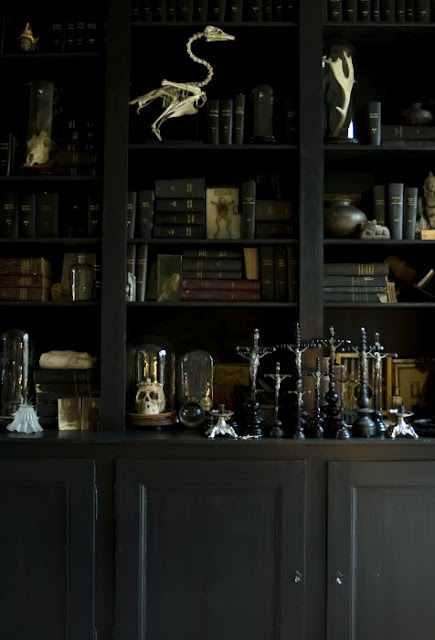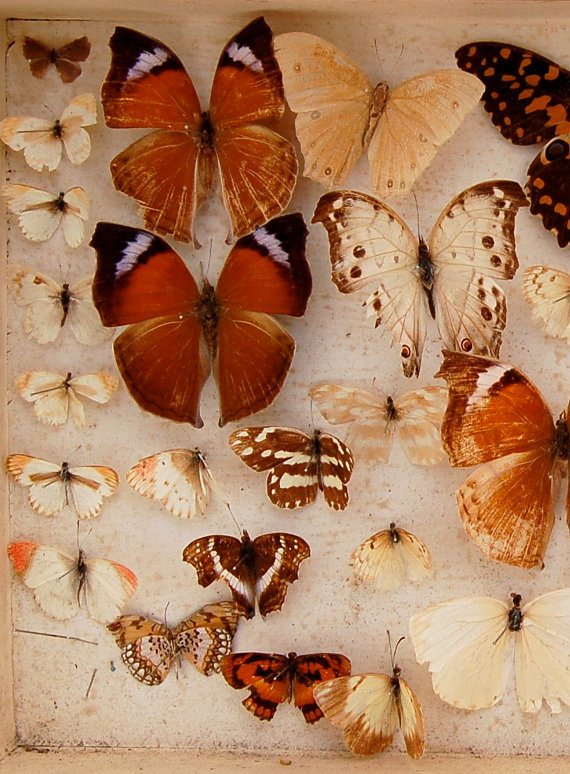 |
| I adore their collection of crucifixes! Note the mingling of oddities with books.... Source: Tumblr |
Step One: Acquiring a Cabinet
While not one-hundred percent necessary for a more general oddities collection, a nice touch, and really, the defining touch to your Cabinet of Curiosities is, of course, the cabinet! Finding a suitable display case can be a treasure hunt of its own, but there are plenty of options commercially available if you are willing to spend the money. Thrift stores with large furniture selections usually have hutches or china cabinets available that could be fitted to work, and of course, ebay always has (sometimes pricey) selection of antique apothecary shelves available for purchase.
Step Two: Beginning Your Collection
Traditional curiosity cabinets were comprised of a combination of natural and man-made artifacts. Collectors would display sea fans and shells next to plater casts of grecian statues and sometimes obvious fakes "proving" the existence of mythical creatures (such as the "Piece of Skin from the Serpent in the Garden of Eden" below). Although for a while these collections were considered educational, their real purpose was to engender awe in their viewers, and capture an appreciation for the world around them. As the Age of Reason dawned, the organization of these collections began to be more motivated by scientific method and were divided into classifications for research. Eventually, wunderkammen evolved into modern natural history and art museums. Art and artifacts were separated from natural specimens, and the gaffs and mythological pieces were removed all together.
 |
| This specimen was a showcase piece in the curiosity collection of Charles F. Gunther, a successful confectioner in Victorian Chicago who was well known for his vast and eccentric collection. In addition to owning many legitamate and important historical artifacts in his collection, he also was the proud owner of pieces like this, "A Piece of Skin from the Serpent in the Garden of Eden". Cataloging textile pieces from Gunther's collection was one of my jobs when I worked at the Chicago History Museum! |
Modern curiosity cabinets in many ways harken back to the original wunderkammen of the Northern Renaissance. Most private collections these days are not intended for methodical scientific study, but rather to express one's aesthetic and interests, and to display items which whet one's curiosity and wonder. Modern collections do not have to abide by any traditional guidelines. Mechanical wonders, art, dolls, things found on walks, urban refuse, your cat's meal remains.... the sky is the limit!
 |
| Cased Victorian Butterfly Collection featured on Shop Oddities tumblr. Available on Etsy here. |
All this thinking about collecting is very exciting but beginning a collection can be daunting. Like building a wardrobe, a collection should be fairly thematic if you want to clearly communicate an idea or aesthetic. It is a good idea to choose a theme for your collection, or narrow the things you want to collect down to a few specific kinds of items. Once you have a basic collection down, you can build from there. Some ideas for themes could be Natural History (bug collections, bird skins, articulated animal skeletons), medical paraphernalia, funerary items, or religious artifacts. Ideally, these things should have some personal significance, but they can also just be things you think are cool!!
 |
| A collection of glass eyes which belong to the last lady glass eye blower in the UK: From the Royal Berkshire Medical Museum Collection. I would die to have these in my collection! |
Since a curiosity cabinet is a central part of your home's decor, its a good idea to discuss your collecting plans with your partner or family if you share your home. My boyfriend and I are both excited to start building our own oddities collection, but we have agreed together that we will not be collecting any human remains, pickled things, or mortuary ephemera, on his request, and nothing associated with black magic/summoning on my request. We have agreed we want to stick with natural history artifacts, medical equipment, and religious artifacts.
 |
| DIY Curiosity Cabinet from the Jewelry Tutorials blog, who run the EtsyMetals blog ring. The linked article talks about what they do to inspire them as jewelers, and maintaining a curiosity cabinet is on the list! |
If you are on a budget, or just aren't sure what direction you want to go with your collection, its also perfectly acceptable for your wunderkammer to be made up of little things that have no significance other than that you like them. Your curiosities don't have to be valuable, or rare, or even beautiful to be special to you. Maybe the most important function of a curiosity cabinet is to store and elevate items that have emotional significance to you. To have them somewhere where you can look at them and remember those feelings and feel proud of the object, and not just keep it in a drawer.
Step Three: Oddities Odds n' Ends
So you're ready to turn your collection into a full blown curiosity cabinet. Here are a few useful links for where to get things you'll need or want, inspiration, research sources, and other like-minds. I only have US locations right now. If you know of any others, feel free to comment and I'll add them to the list!! Happy collecting!!!
Those nifty glass domes:
Oddities shops:
Obscura - New York, New York http://www.obscuraantiques.com/
Necromance - Los Angeles, California http://necromance.com/
Wooly Mammoth - Chicago, Illinois http://www.woollymammothchicago.com/
Loved to Death - San Francisco, California http://www.lovedtodeath.net/
Evolution - New York, New York http://theevolutionstore.com/
Pandora's Parlour - http://pandorasparlor.blogspot.com/
Museums and Public Collections:
The Mutter Museum - Philadelphia, Pennsylvania
The Museum of Jurassic Technology - Santa Monica, California - http://mjt.org/
Ripley's Believe it Or Not Museums - your local tourist town http://www.ripleys.com/weird/


Enjoyed this article and photos. Please consider adding me to your kindred spirits. I create humorous scenes using mechanically enhanced insects and miniatures. All are ensconsed under a glass dome with glass foot and decorated with black satin trim and tassle. Thanks. Julia McLane
ReplyDeletehttp://www.etsy.com/shop/odditiesandcuriosi
I myself am an avid collector, but on a meager budget. I waited 30 years to get a stuffed turtle & 20 years to obtain a grand tour bronze of Hermes seated ...then I began to create my own exhibits...This year I had my 1st solo exhibition at an award winning museum. Newspapers dubbed my exhibition 'Museum of the Impossible'. Now I'm making available some of my sculptures, 'oddities' I believe some call them. https://www.etsy.com/uk/shop/KuriousThings
ReplyDelete